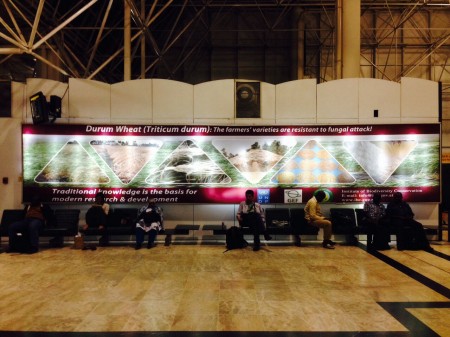- Secretary of Agriculture tours Ft Collins genebank. With video goodness.
- Which genebank I’m sure follows the Genebank Standards for Plant Genetic Resources for Food and Agriculture. With video goodness.
- Prince of Wales sows organic rice. In white suit. With video goodness.
- The story of indigo. No video, but lots of photos.
- Sardinian blood soup. No video, but one photo. Which is more than enough.
- Wanna watch Seeds of Time? Here’s where. Includes much on Svalbard, of course. And a bit on USDA wild potato collecting. I plead the fifth.
- So there’s a second banana genome? Thankfully no video.
- “We are only using the tip of the iceberg.” Rice genetic resources, that is. Could easily have had a video.
- Face palm oil.
- Photo essay on the bazaars of Central Asia.
Nibbles: Fungi, Beer, Cupuaçu, Tearless onions, Melaleuca, Tomatillo, Seed takeover, Katy Perry’s seeds, Bruges fries, EU ag
- They got an awful lot of fungi in Norwegian wood.
- Waiter, there’s a mushroom in my beer.
- Kew seed scientist discovers the taste of the Amazon.
- That “tearless onion” is good for the heart story? The article is behind a paywall, so I don’t know how the boffins suppressed lachrymatory factor synthase. And frankly, I don’t really care.
- A new guide to Melaleuca species. Be still my beating heart.
- The world’s oldest tomatillo clocks in at 52.2 million years.
- French seed company Vilmorin buys 25% of Zimbabwe’s Seed Co. Ltd. What could possibly go wrong?
- “Katy Perry’s latest album, Prism, is Number One in Australia, but that hasn’t stopped the country from declaring it a potential biohazard.” Can anyone explain the significance of this story? Or who Katy Perry is?
- On the whole, I’d rather be at the frites museum in Bruges.
- “Clearly, when it comes to agriculture, productivity matters.” Here comes the science.
Nibbles: Soil testing kit, Sustainable farming, Coffee and climate change, BGI genebank, Bamboo genebank, Genebank management, India’s malnutrition, Phenotyping conference, CIP genebank video, CG impact, Feed the World
Luigi went on a three-week trip, and all he came back with was this:
- A new soil testing kit? Really?
- Ok, how about a SciDev Spotlight featurette on sustainable farming? No? Well, can I tempt you with the British Ecological Society on agroecology then?
- Oh, I bet this thing on coffee and climate change will hit home.
- I’m pretty sure news of yet another Chinese genebank (of sorts) won’t.
- Pssst. Got room for a new bamboo genebank too?
- They’ll need a genebank management system, won’t they? GRIN and bear it.
- News too of hunger and malnutrition in India, by Indians, for … er …
- Phenotyping conference, anyone? Anyone at all? Some EU breeders will no doubt be there. And some of them at least will find a new map of water risk useful in their work.
- And to end with, Al Jazeera on the CIP potato genebank. You heard me.
- As you were, there’s the CGIAR Knowledge Day too, all about delivery and impact. I wonder if the genebanks will feature…
- Not so fast, there’s also a live webcast of the conference Feeding the World without Consuming the Planet that awaits you.
Brainfood: Pollinator communities, Supply chains and deforestation, Restoration in cities and connected landscapes, Forages in China, Forages in Australia, Indian eggplant minerals, Mediterranean eggplant, Carpathian agrotourism, Nordic apples, Hungarian grape, Saline SP
- Landscape heterogeneity and farming practice alter the species composition and taxonomic breadth of pollinator communities. Pollinator species richness decreases along with landscape heterogeneity, but different taxonomic groups do different things, so you have to consider composition.
- Enhancing the sustainability of commodity supply chains in tropical forest and agricultural landscapes. You got your institutions, policies, incentives, information and technologies, and now you’ve got a framework to work out how they can combine to produce the desired outcome of less deforestation from the production of agricultural commodities like beef, cocoa, palm oil, rubber and soybean. That’s the theory done, now on with the practice. Which basically comes down to governance.
- Urban Grassland Restoration: A Neglected Opportunity for Biodiversity Conservation. Beyond green roofs. Rooves?
- A Framework to Optimize Biodiversity Restoration Efforts Based on Habitat Amount and Landscape Connectivity. I guess we should apply this to the above? It’s the lack of connectivity that’s gonna kill ya in those urban landscapes.
- Research Progress of Forage Germplasm Resources Innovation in China. Among other things, that progress came with “ion beam implantation” and “spaceship-carried”, which really makes me want to read beyond the abstract, which however would require knowledge of Chinese. If there’s anyone out there who can explain the spaceship, I’d be thrilled.
- Pasture legumes in Queensland: a new wave? Maybe, but if so very much on the cheap. No spaceships in Oz.
- Mineral composition and their genetic variability analysis in eggplant (Solanum melongena L.) germplasm. 2 out of 32 Indian genebank accessions were good for wide range of minerals.
- The Population Structure and Diversity of Eggplant from Asia and the Mediterranean Basin. An eastern and a western genepool according to SSRs, and 3 parallel morphological groups in each of these. No word on their mineral content.
- Green economy and agri-rural tourism. Marketing local eco-bio-products are the way forward for the Carpathians. Would pay money to see that.
- Genetic diversity in Swedish and Finnish heirloom apple cultivars revealed with SSR markers. The Finnish ones are weird.
- Morphological and molecular characterization of varieties and selected clones of ‘Kadarka’ grape. Formerly the widest grown red wine cultivar in Hungary, and a total nomenclatural mess.
- Using salt-tolerant sweet potato varieties in Than Hoa Province, Vietnam. Ok, maybe not peer-reviewed, but interesting as hell. From 530 genebank accessions to 2 promising cultivars, via lab and field trials.
